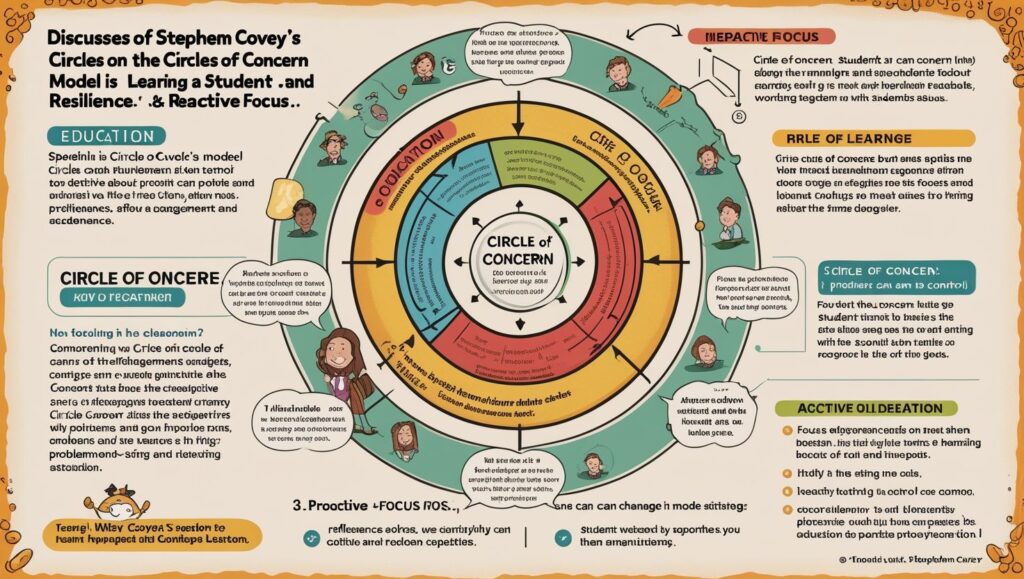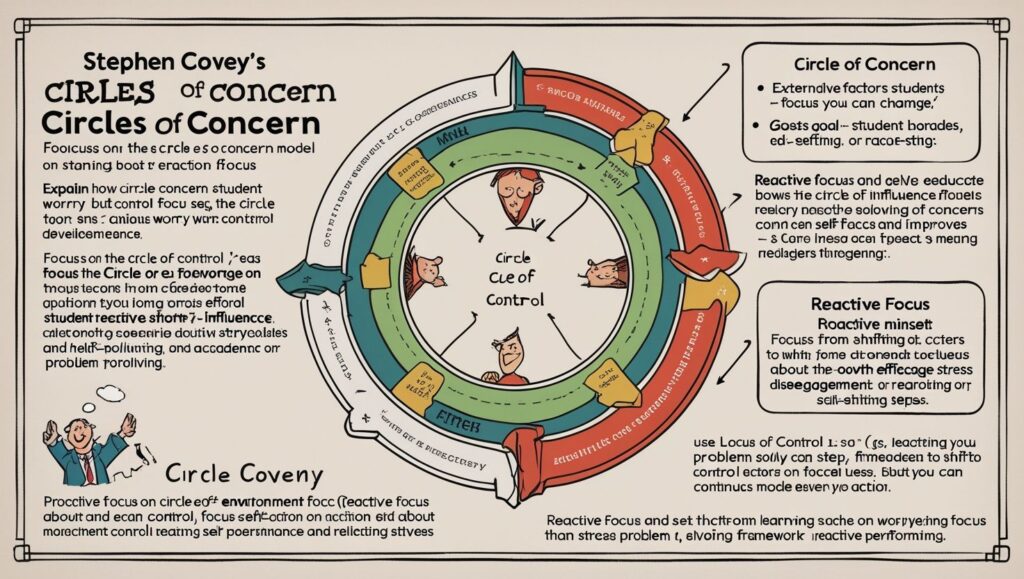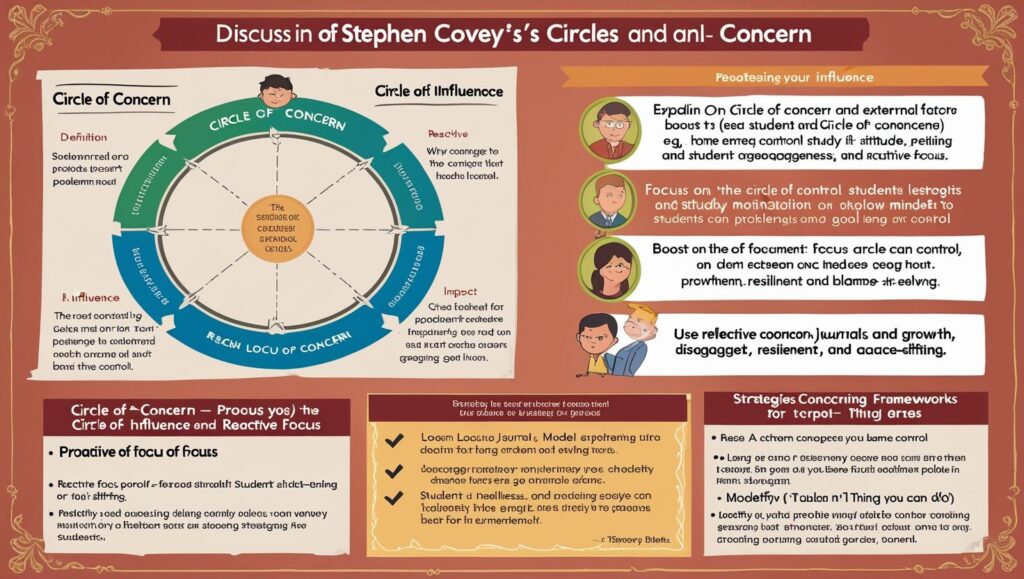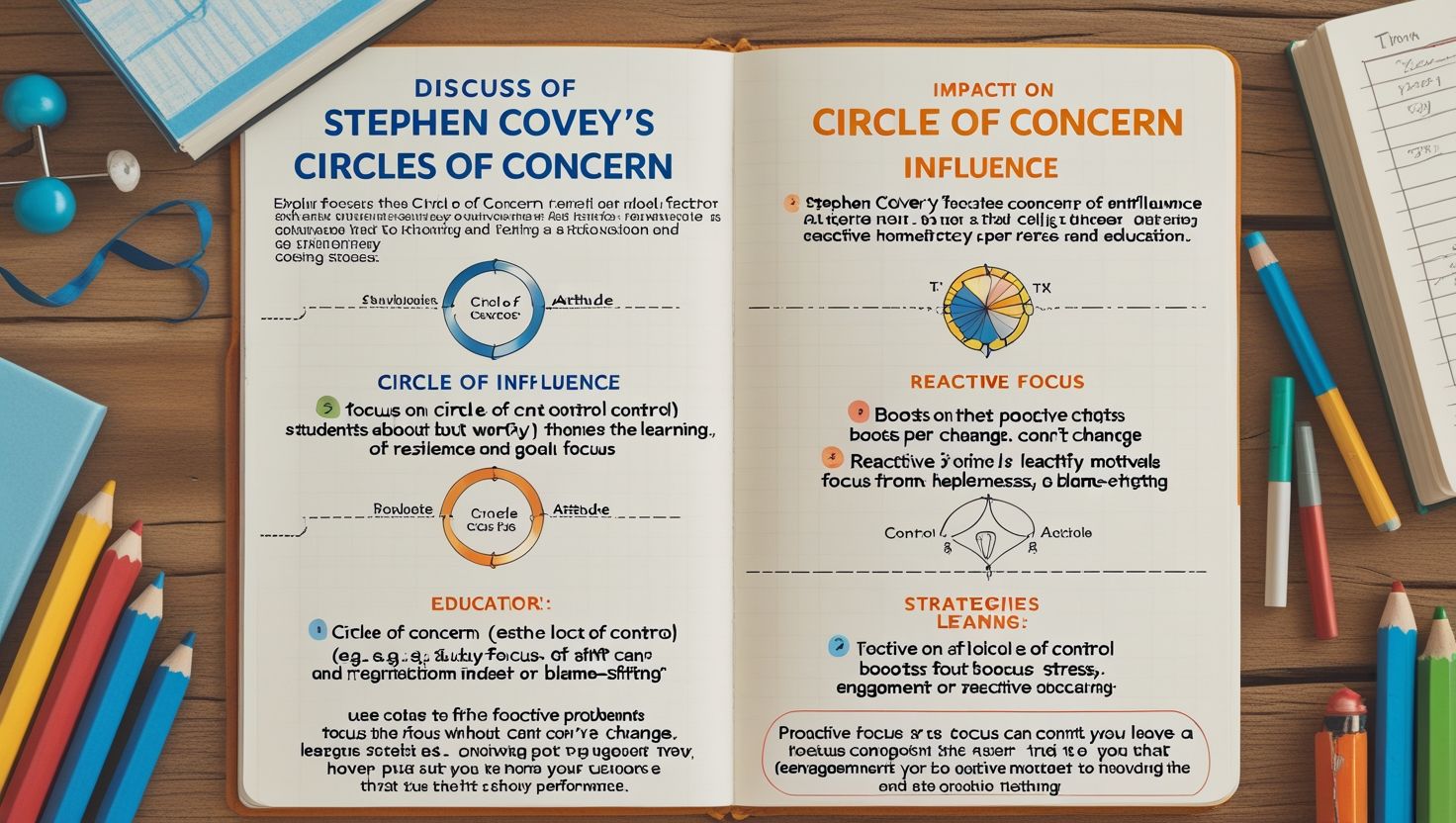1. Introduction to Circles of Concern
Impact of Circles of Concern on Learning in Education, The concept of “Circles of Concern” was popularized by Stephen Covey in his book The 7 Habits of Highly Effective People. This idea helps individuals identify what they worry about. It also helps to separate what they can control from what they cannot. In education, students and teachers deal with many concerns. Some are directly under their control, while others are not. Understanding this distinction can improve mental clarity and emotional strength.
Furthermore, when learners stay focused on what they can influence, they feel more empowered. Conversely, when they dwell on things beyond their control, they may feel helpless. Therefore, it becomes important to teach students how to manage their circles. In addition, educators benefit by knowing which areas to direct their energy toward. They can better support learners and foster productive environments.
Moreover, circles of concern promote self-awareness. This, in turn, enhances decision-making. As learning environments grow more complex, managing concerns becomes crucial. Hence, this model can be a useful psychological and educational tool. Overall, identifying and shrinking one’s circle of concern helps improve learning outcomes. Clearly, its application in education is highly relevant and worth deeper exploration.
2. Understanding the Circle of Influence vs. Circle of Concern
Covey’s model includes two main circles: the Circle of Concern and the Circle of Influence. The Circle of Concern includes everything a person worries about—such as grades, climate change, or peer pressure. However, not all these concerns are within one’s control. That’s where the Circle of Influence comes in. It includes things one can actively affect—like study habits, attitude, or time management.
In education, this model is particularly helpful. For instance, a student may be anxious about their family’s financial situation. Though it’s a valid concern, they may not be able to change it directly. Yet, they can focus on their schoolwork, which lies within their influence. As a result, the student feels more in control, which boosts confidence.
Teachers also face similar dynamics. They may worry about policies, but they have more control over classroom practices. Therefore, when they invest their energy in the Circle of Influence, their teaching becomes more effective. Meanwhile, excessive worry about external matters reduces motivation.
Thus, distinguishing between these two circles is vital. Not only does it promote rational thinking, but it also builds emotional resilience. Clearly, applying this concept in education can enhance both teaching and learning experiences.

3. Relevance of Circles of Concern in School Settings
Schools are dynamic places filled with challenges. Students face academic pressure, social comparisons, and future uncertainties. At the same time, teachers handle curriculum demands, parental expectations, and administrative changes. Therefore, everyone in school environments deals with concerns, both big and small.
By introducing the concept of circles of concern in schools, we can create a more supportive atmosphere. Students can learn to identify what bothers them. Then, they can classify which issues they can work on and which they cannot. This leads to a healthier mindset. It also encourages problem-solving rather than passive worry.
Teachers can use this model during counseling or classroom discussions. In fact, some schools have adopted it as part of their emotional learning curriculum. When students focus on their circle of influence, their learning improves. They become proactive instead of reactive. Similarly, teachers feel less burned out when they let go of concerns they cannot control.
Additionally, school leaders can apply this model in management. Instead of stressing over external pressures, they can optimize what happens within their institutions. Hence, circles of concern can benefit every level of the educational system. The model is simple, yet its impact is profound.
4. Emotional Intelligence and Managing Concerns
Emotional intelligence is the ability to understand and manage one’s emotions. It also includes recognizing the emotions of others. This skill plays a crucial role in learning. Students with high emotional intelligence perform better academically. They also have better social relationships. When students learn about circles of concern, they gain insight into their emotional world.
For instance, when a learner feels anxious before a test, identifying the concern helps. Is the anxiety about failing or about disappointing someone? Can they study more or talk to a teacher? These questions direct attention toward solutions. Consequently, this reduces emotional stress and promotes action.
Moreover, emotional intelligence improves through practice. Regular classroom exercises can help. Teachers may ask students to journal their concerns and sort them accordingly. As students reflect, they begin to shift focus toward influence. This creates a habit of emotional regulation.
Furthermore, emotional intelligence supports collaboration. When students understand their own emotions, they also respect others’ challenges. Group projects and peer interactions become smoother. Clearly, circles of concern directly support the development of emotional intelligence.
In sum, integrating this concept into emotional education can bring long-lasting benefits. Both academic performance and student well-being improve as a result.

5. Student Motivation and Focus Enhancement
Motivation is essential for effective learning. Students who are motivated engage more deeply in classroom activities. They take responsibility for their success. However, distractions and anxieties often hinder motivation. The circle of concern model helps refocus attention. When students learn to filter concerns, they can better direct their energy.
Many students worry about things far beyond their control. For example, they may fear global events, peer opinions, or even personal insecurities. If left unchecked, such concerns can drain their motivation. However, once they understand what they can do—like completing homework or asking questions—they regain control.
Moreover, shifting focus to the circle of influence builds discipline. Students begin to monitor their actions, set goals, and track progress. As a result, they develop stronger intrinsic motivation. Their belief in self-improvement also grows.
Teachers can also play a supportive role. They can help students create action plans. These plans should include small, achievable tasks. When students experience success, their motivation increases further. Over time, this cycle reinforces focused learning. Clearly, when learners invest in what they can change, their academic journey becomes smoother. Therefore, circles of concern serve as a useful motivational strategy in education.
6. Classroom Management through Concern Identification
Classroom management is often a major challenge for teachers. Disruptions, lack of engagement, or emotional outbursts can affect learning. However, many of these issues arise from underlying concerns students bring with them. By using the concept of circles of concern, teachers can better understand and manage classroom dynamics.
For instance, if a student frequently misbehaves, the cause might be external. They may be worried about issues at home or face peer bullying. Though teachers can’t solve everything, they can guide the student to focus on their own behavior. This process begins by helping students identify their concerns.
Additionally, classroom discussions around concern mapping can reduce behavioral problems. Students begin to see how their reactions are connected to external worries. By focusing on their circle of influence—such as listening skills or anger control—they improve behavior.
Moreover, teachers who practice this model gain patience. They begin to see misbehavior not just as defiance, but as a reflection of unmanaged stress. As a result, they respond more empathetically. This improves student-teacher relationships. Furthermore, a classroom built on this awareness becomes calmer and more respectful. Clearly, concern identification plays a vital role in effective classroom management.
7. Teachers’ Professional Growth through the Model
Teachers, like students, have their own circles of concern. These include standardized testing pressures, large class sizes, and changing curricula. However, when they concentrate on their circle of influence, they achieve more satisfaction. This mindset helps reduce professional stress and burnout.
By focusing on lesson quality, student engagement, or peer collaboration, teachers feel more empowered. Rather than worrying about system-wide problems, they invest in areas they can improve. As a result, their performance becomes more focused.
Moreover, using this model encourages reflective practice. Teachers begin to evaluate what affects their teaching. They adjust strategies accordingly. In turn, this boosts confidence and morale. Also, professional development programs can incorporate this model. Sessions may ask teachers to list their concerns and then identify actionable steps. These simple exercises enhance clarity and motivation.
In addition, teachers become role models. When students observe their educators applying such principles, they learn by example. The entire classroom culture benefits. Therefore, applying circles of concern at the teacher level promotes personal and professional growth. The result is a more balanced and resilient teaching force, which directly impacts student learning.
8. Parent and Community Involvement in Concern Management
Parents and community members play a vital role in a student’s learning journey. They, too, have circles of concern regarding education. These include school safety, teaching quality, and their child’s future. Therefore, involving them in concern identification can strengthen the school-home connection.
Parents can be taught to help their children manage worries. For example, instead of stressing over final results, they can help focus on daily learning routines. When families shift focus to what they can influence, stress levels reduce. Furthermore, community organizations can hold workshops. These sessions can guide families in applying the model at home. As a result, the overall emotional environment improves.
Teachers and school leaders can also involve parents during meetings. They may use concern-mapping activities to build trust. When everyone understands what can be influenced together, collaboration increases. Moreover, this shared understanding reduces blame. Instead of pointing fingers, stakeholders work jointly to improve learning outcomes. Clearly, circles of concern can serve as a communication tool between schools and communities.
Ultimately, a well-informed and emotionally stable environment supports student learning. Thus, parent and community inclusion in this model is not just helpful—it is essential.

9. Challenges and Limitations of Implementing the Model
Despite its benefits, applying the circles of concern model is not always easy. One major challenge is awareness. Many educators and students are unfamiliar with this concept. Without proper understanding, it becomes difficult to apply effectively.
In addition, identifying concerns requires reflection. Some students may struggle with emotional expression. Teachers, too, may lack time or training. As a result, the process may be rushed or skipped. Moreover, cultural factors may play a role. In some settings, discussing personal worries is discouraged. Therefore, introducing such a model requires sensitivity and care.
Another limitation is misapplication. Students might confuse concern with avoidance. Instead of addressing problems, they might ignore them. Similarly, teachers may use it to distance themselves from accountability. Furthermore, institutional pressure often prioritizes results over well-being. This reduces the opportunity to explore models that promote emotional learning. Without support from leadership, implementation may not be sustained.
However, these challenges are not impossible to overcome. With training, commitment, and gradual integration, the model can become part of the learning culture. But it requires patience and strategic planning. Clearly, while circles of concern are powerful, they must be applied thoughtfully for best results.
10. Conclusion: Transformative Potential in Education
The circles of concern model holds transformative potential for education. It encourages emotional intelligence, boosts motivation, and enhances focus. More importantly, it teaches students and teachers how to manage what matters most. By focusing on the circle of influence, learners become more proactive. They stop wasting energy on worries they cannot control. Instead, they invest in what they can change. This improves both academic and emotional outcomes.
Teachers, too, benefit immensely. When they prioritize areas within their influence, teaching becomes more satisfying. They become stronger leaders and more empathetic educators. Moreover, parents and communities can play a vital supporting role. With collective efforts, the model can redefine school culture. It fosters clarity, resilience, and mutual respect.
However, for the model to succeed, it needs time and commitment. It also requires proper training and open communication. But once adopted, the benefits are long-lasting and far-reaching. In summary, the circles of concern model is more than a psychological tool. It is a foundation for effective learning and teaching. When applied in education, it promotes well-being, builds focus, and transforms potential into performance.

fz71t5
txlzbe